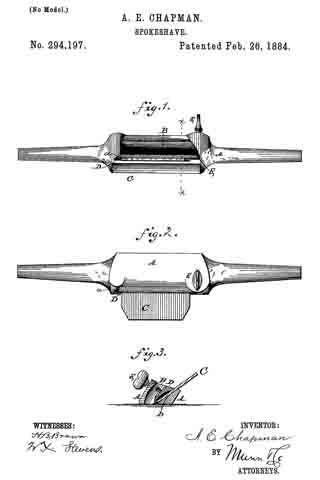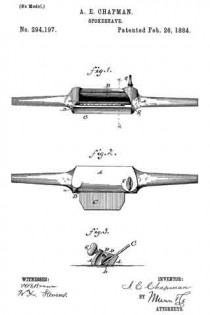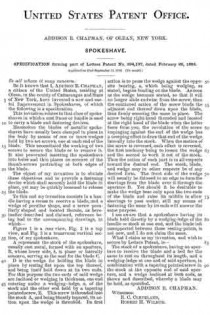
| PLEASE NOTE: The images presented on this page are of low resolution and, as a result, will not print out very well. If you wish to have higher resolution files then you may purchase them for only $2.95 per patent by using the "Buy Now" button below. All purchases are via PayPal. These files have all been cleaned up and digitally enhanced and are therefore suitable for printing, publication or framing. Each zip package contains all the images below (some packages may contain more), and purchased files can be downloaded immediately. |
UNITED STATES PATENT OFFICE.
_________________
ADDISON E. CHAPMAN, OF OLEAN, NEW YORK.
SPOKESHAVE.
_________________
SPECIFICATION forming part of Letters Patent No. 294,197, dated February 26, 1884.
Application filed September 11, 1883. (No model.)
_________________
To all whom it may concern:
Be it known that I, ADDISON E. CHAPMAN, a citizen of the United States, residing at Olean, in the county of Cattaraugus and State of New York, have invented a new and useful Improvement in Spokeshaves, of which the following is a specification.
This invention relates to that class of spoke-shaves in which a cast frame or handle is used to carry a blade and fastening devices.
Heretofore the blades of metallic spoke-shaves have usually been clamped in place in the body by means of one or more wedges held by two setscrews, one at each end of the blade. This necessitated the working of two screws to secure the blade or to remove it. It also prevented inserting the spokeshave into holes and thin places on account of the thumb-screws protruding at both edges of the blade.
The object of my invention is to obviate these objections and to provide a fastening device which shall securely hold the blade in place, yet may be quickly loosened to release the blade.
To this end my invention consists in a handle having a recess to receive a blade, and a wedge of peculiar shape, and a screw peculiarly shaped and located therein, as hereinafter described and claimed, reference being had to the accompanying drawings, in which —
Figure 1 is a rear view, Fig. 2 is a top view, and Fig. 3 is a transverse vertical section, of my spokeshave.
A represents the stock of the spokeshave, usually cast metal, formed with an aperture, B, whose lower side, b, is plane or laterally concave, serving as the seat for the blade C.
D is the wedge for holding the blade in place by resting flat upon the top thereof, and being itself held down at its two ends. For this purpose the two ends of said wedge are inclined or wedging in thickness, one end entering under a wedging-ledge, a, of the stock and the other end held by a tapering pointed screw, E. This screw is threaded into the stock A, and being bluntly tapered, its action upon the wedge is threefold. Its first action is to press the wedge against the opposite bearing, a, which being wedging, as stated, begins binding on the blade. As soon as the wedge becomes seated, so that it will no longer slide endwise from the screw, then the continued action of the screw binds the adjacent end thereof down upon the blade, thus firnily securing the same in place. The screw being right-hand threaded and located at the right hand of the blade when the latter faces from you, the revolution of the screw impinging against the end of the wedge has a creeping effect to draw that end of the wedge laterally into the stock. When the motion of the screw is reversed, each effect is reversed, the first tendency being to loosen the wedge and the second to work it out of the stock. Thus the action of each part is in all respects toward the desired end. The stock, blade, and wedge may in other respects be of any desired form. The front side of the wedge will usually be thinned to an edge to turn the shavings from the blade over it through the aperture B. Yet should it be desirable to make the wedge bear only upon the two ends of the blade and raise its middle to allow shavings to pass under, still my means of fastening the same by its ends will answer the same purpose.
I am aware that a spokeshave having its blade held directly by a wedging-edge of the handle or stock at one end, and the blade left unsupported between these resting-points, is not new, and I do not claim the same.
What I claim as my invention, and wish to secure by Letters Patent, is —
The stock of a spokeshave, having an aperture to receive the blade and a bed for the same to rest on throughout its length, and a wedging-ledge at one end of said aperture, in combination with a tapering pointed screw in the stock at the opposite end of said aperture, and a wedge inclined at both ends, as shown and described, whereby a blade may be held, as specified.
ADDISON E. CHAPMAN.
Witnesses:
E. C. CLEVELAND,
ROBERT H. WILBUR.


